Hello there,
I’m back with a new article. This will be a look at a companion arc, in this case featuring Thomas Hector Schofield also known as Hex. Hex was Big Finish’s first original companion for the Seventh Doctor and traveled alongside the Doctor and Ace. While Hex is primarily an audio companion played by Philip Olivier, he’s also appeared in a handful of stories from the print Short Trips collections from Big Finish.
I will try to put the audios in chronological order for Hex, though there are three that were released after Hex’s final departure that are harder to place. The Short Trips will be very vague and included after the audios. As I either haven’t read any of them or maybe a couple very long ago (these collections are difficult to get a hold of), my comments will be very limited, possibly to just the most basic of information.
As with all my articles, there will be spoilers throughout. Most of these are six years old or older and thus I consider the statute of limitations on spoilers to have lifted. However, the three released after the arc ended, especially the most recent one from September 2020, are a bit more recent. Feel free to skip those entries if you’re worried about spoilers. However, from this point on, note that you have been warned.
Hex is a special character in that the Doctor has had precious experience with him in the form of his mother Cassie from “Project: Twilight” and “Project: Lazarus” which are (primarily) Sixth Doctor and Evelyn stories. He’s also the first nurse companion and, as far as I can tell, the second companion with a medical background after Harry Sullivan.
I’ll get more into Hex as a character later, but I’ll say here that I really like Hex as a companion. As the fourth original companion created by Big Finish (after Evelyn, Charley, and Erimem), he’s really well written and offers a sharp contrast to Ace. But more on that later, let’s get into the stories.
The Stories
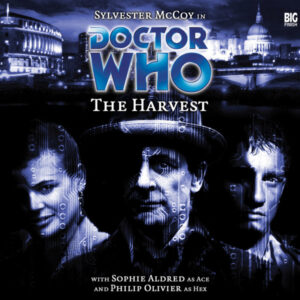 We’re introduced to Hex in The Harvest. Here we meet Staff Nurse Schofield on his 23rd birthday. As opposed to some companions who only have a slight reaction to the adventure they’re thrown into, Hex comes across as a likable average bloke who has a hard time adapting to the fantastic and dangerous world he’s just entered. His first encounter with the TARDIS produces several “Oh my God”s.
We’re introduced to Hex in The Harvest. Here we meet Staff Nurse Schofield on his 23rd birthday. As opposed to some companions who only have a slight reaction to the adventure they’re thrown into, Hex comes across as a likable average bloke who has a hard time adapting to the fantastic and dangerous world he’s just entered. His first encounter with the TARDIS produces several “Oh my God”s.
The plot of the Harvest is excellent and very well acted. Essentially, the Doctor and McShane (see the Big Finish stories “Colditz” and “The Rapture” for the history behind this) are at St. Gart’s Hospital investigating the use of xenotech. The date is October 12, 2021, and the EU is using Cybertech to further its space program. Meanwhile, the Cybermen are involved in a scheme to become human again in order to regain advantages that humans have but that the Cybermen have lost. And into this is thrown Hex.
This is very worth listening to. Not only is it necessary for Hex’s arc as his introduction, it’s also just a really good story. Ace seems older, wiser. And the Doctor is more plotting and scheming than jokey or screaming, the latter something that often doesn’t work as well on audio as on TV. This story has a spy thriller/techno-thriller vibe to it and is just a joy to listen to. The biggest things that don’t seem plausible with this story anymore are the lack of Covid and the fact that Brexit never happened, things that couldn’t have been imagined when this was released in 2004. I’d rate this at 10/10. As for Traveling the Vortex’s review of this story, see Episode #239 from July 2015.
The next story is Dreamtime, which is an odd one. It’s Hex’s first trip in the TARDIS bringing the crew to Uluru (Ayers Rock) in the far future. He gets his first spaceship, first alien species and first trip off Earth, sort of. Then,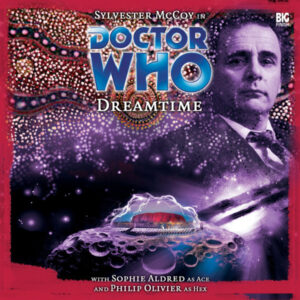 he gets thrown in the deep end as the Doctor disappears and Hex and Ace end up splitting up.
he gets thrown in the deep end as the Doctor disappears and Hex and Ace end up splitting up.
Essentially, when the Earth was near destruction in the far future, a group of native Australians gathered around Uluru following a Guru named Baiame. The colony launches itself into space but is slowly taken over by the mysterious Dreamtime, a powerful, ancient force. The Doctor and crew land several years later followed shortly by a Galyari (see Big Finish story “The Sandman”) ship.
It’s not a terrible story. I feel at a disadvantage because I don’t know anything about the Australian Aboriginal folklore that seems to be a big part of this. It feels confusing but is one of those stories where there’s no real villain or enemy and where everybody lives. The cast do fine, and I continue liking Hex. I’d rate this 4/10. As for Traveling the Vortex’s review of this story, see Episode #298 from September 2016.
The third story in the line is the wonderful LIVE 34. Another of Big Finish’s experimental stories, this one taking place over sixteen days on a distant Earth Colony and told entirely in the form of radio broadcasts. And, it works really well. Featuring the Doctor and crew overturning a dictator, it feels surprisingly relevant to the political climate of 2020.
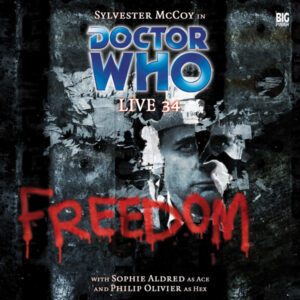 While the Doctor shows up in all four parts, Ace doesn’t appear until Part 2 and Hex doesn’t appear until Part 3. There’s also no theme music denoting episodes. Instead, there’s a short bit of increased static and tiny fragments of recordings. The cast does exceptionally well in this, with McCoy giving another quiet performance until the end and even then, the shouting works well. We also get a bit of backstory on Hex when asked why he became a paramedic.
While the Doctor shows up in all four parts, Ace doesn’t appear until Part 2 and Hex doesn’t appear until Part 3. There’s also no theme music denoting episodes. Instead, there’s a short bit of increased static and tiny fragments of recordings. The cast does exceptionally well in this, with McCoy giving another quiet performance until the end and even then, the shouting works well. We also get a bit of backstory on Hex when asked why he became a paramedic.
Part Four, which takes place on Election Day and where everything we’ve been shown thus far comes together, is brilliant and very well done. This is a story that you just have to listen to for yourself. Apart from possibly needing a basic understanding of Seven and Ace, and just knowing that Hex is the new companion, this story is a very good introduction for people new to Big Finish. It’s easy to get into, the format lends itself to the average person, and apart from knowing who the TARDIS crew is on a basic level, there’s no backstory that’s required to understand the plot (unlike later entries in this run like Project: Destiny for example). I’d rate this story at 10/10. As for Traveling the Vortex’s review of this story, see Episode #313 from January 2017.
The next story in line, as best as I can tell based on various sources, is Shadow Planet / World Apart. This is an anomaly in the Hex arc in that it is Main Range release #226 and was published just under three years after the Hex arc ended in Main Range #191 (which will be covered later in this article). There are two other releases that were released after the arc ended that we’ll get to later. As for placement as mentioned in the CD Extras, it’s simply early in the run because there are still hints of a potential romance between Hex and Ace.
This is a release that I haven’t actually listened to before, so this is my first time experiencing these stories. That’s right, stories. This is one of a handful of Main Range releases that were made up of two two-part stories. This is the last of a loose trilogy (and I use the word “trilogy” in the loosest of terms) that featured this format. It will be used again in the Main Range again twice for a total of four more releases, one of which is another Seven/Ace/Hex release that we’ll be covered down the line.
Shadow Planet is an interesting and decent story. While the Doctor works on the TARDIS, Ace is bored. A look through the database for nearby planets comes up with Unity, a physic planet where the Unity Corporation helps you fight your shadow self and come out a better, happier person. What could go wrong?
helps you fight your shadow self and come out a better, happier person. What could go wrong?
It’s a standard story with good ideas, centering essentially on yin and yang, and corporate greed. We get a little bit of insight into Ace and Hex via their Shadows, but there’s not that much depth to this story. It’s still good though, and the end cliffhanger’s into the next story that makes up the next half of this release.
World Apart is another interesting story. After leaving the Shadow Planet, the TARDIS finds itself vying for space in the vortex as something massive appears in its path. The TARDIS manages to land on something which is revealed to be the rogue planet Nirvana which is known to phase in and out of the universe. This becomes a stark survivor story when Ace and Hex end up trapped on the frozen planet after the planet shifts out of the universe before they can reach the TARDIS.
This is a rather bleak story, especially the second part. It’s well-acted, but still not a favorite in my opinion. Of course, the Doctor saves them in the end, but Hex is still quite upset and hurt. We get more into the mindsets of Ace and Hex a bit here, but there aren’t any great revelations.
This is my first time listening to these, and I don’t think I’ll return to them anytime soon. As a whole, I’d rate this release at 6/10 with Shadow Planet receiving a 6.5/10 and World Apart receiving a 5/10. They’re not terrible stories, and they’re not confusing or hard to understand. As for Traveling the Vortex’s review of this story, as this was released after the initial run of Hex stories, they have yet to review this one.
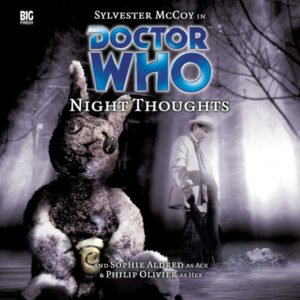 Next in line is Night Thoughts. This is an interesting story historically because it was originally submitted as a three-part story for the canceled Season 27. As this was released before the creation of “The Lost Stories” range from Big Finish, it was converted into a four-part story and Hex was added.
Next in line is Night Thoughts. This is an interesting story historically because it was originally submitted as a three-part story for the canceled Season 27. As this was released before the creation of “The Lost Stories” range from Big Finish, it was converted into a four-part story and Hex was added.
It is said that the memory cheats, and going into this story this time around, I remembered not caring for it much. I was pleasantly surprised. It’s a very good story that feels similar to Ghost Light in tone and atmosphere. The Doctor, Ace, and Hex arrive on a Scottish Island in the middle of a stormy night and end up taking shelter with a handful of eccentrics in a house.
From here we get very colorful characters, murder, mystery, and time experiments. It has a murder mystery feel tied with a slight horror vibe with a tinge of zombie to it. The Doctor is in top form, Hex does well while Ace feels a bit subdued. In amongst everything going on, we get a little background on Hex’s growing up, raised by his Dad and his Gran. We also get a little background on Ace and her Mum carrying on from the revelation in Curse of Fenric.
It takes a bit to figure out where this is going, but we get the pieces of the puzzle slowly dealt out and once it gets there it’s a very good story. Everything seems to be resolved and the Doctor and Co leave for the next adventure. And then we get a really creepy coda acted to perfection by the late Bernard Kay (who starred in The Dalek Invasion of Earth, The Crusade, the Faceless Ones and Colony in Space) as Major Dickens. This is a great story for the Halloween season. Creepy and atmospheric, I rate it at 8/10. As for Traveling the Vortex’s review of this story, see Episode #324 from April 2017.
Next up is The Veiled Leopard, a story that all my timeline sources place the same. Initially released on CD as a bonus with DWM 367, this features Peri and Erimem, and Ace and Hex, each on a separate mission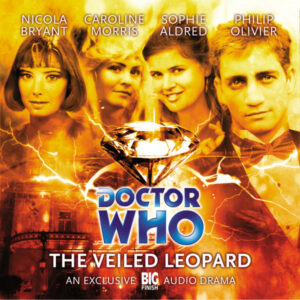 revolving around the theft of the Veiled Leopard diamond similar to the Pink Panther franchise. I think it’s available on the Big Finish Sound Cloud and I think I tried listening to it several years back. I remembering being very confused about what was going on.
revolving around the theft of the Veiled Leopard diamond similar to the Pink Panther franchise. I think it’s available on the Big Finish Sound Cloud and I think I tried listening to it several years back. I remembering being very confused about what was going on.
So, I was going to skip this one this time around because I didn’t feel like trying to track it down. However, I then discovered that I’d picked it up during a sale from Big Finish. So, here goes. The Veiled Leopard is a flawless diamond with lots of little flecks in it giving it its name. It’s resurfaced in Monte Carlo in 1966. The first half of the story is Peri and Erimem tasked by the Fifth Doctor (after a meeting with the Seventh Doctor) to prevent the diamond’s theft at its unveiling.
The second half is Ace and Hex stealing the diamond, which is actually the last remnants of a dead alien race. It feels a little James Bond (think Casino Royale) and very much Pink Panther, though not a comedy. It has good fun, funny moments, but for the most part, is played straight. It’s fun, especially the Peri/Erimem side.
While Ace and Hex are on this mission, the Seventh Doctor is taking part in the audio “Thicker Than Water” (Main Range 73), a Sixth Doctor/Mel/Evelyn story where the Doctor reveals Hex’s parentage to Evelyn, a story thread that will become important down the line for Hex. I’d rate this at 8/10. As for Traveling the Vortex’s review of this story, they have yet to review this one.
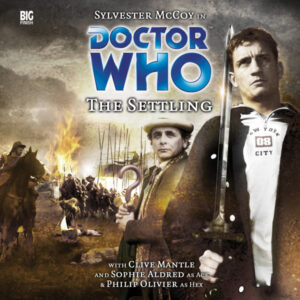 The next story is The Settling which is a pure historical set during and after the Siege of Drogheda in September 1649 during Oliver Cromwell’s war in Ireland. It’s told through flashbacks as Ace helps Hex come to grips with the horrors of history and their part in events. I won’t say much about the plot except that the TARDIS crew gets separated and Hex ends up with Cromwell, and the Doctor helps deliver a baby.
The next story is The Settling which is a pure historical set during and after the Siege of Drogheda in September 1649 during Oliver Cromwell’s war in Ireland. It’s told through flashbacks as Ace helps Hex come to grips with the horrors of history and their part in events. I won’t say much about the plot except that the TARDIS crew gets separated and Hex ends up with Cromwell, and the Doctor helps deliver a baby.
It’s a very good story, well written and very well acted. This is an excellent story for character development, both for Ace and Hex, but especially Hex who takes what happened hard. There’s an aura of melancholy that radiates through the story and in some ways makes it even more enjoyable.
I understand why the pure historicals died out on TV, but if you can make them as good as this, then they deserve a comeback. Making me feel for Cromwell, and making me want to learn more, are definitely pluses to an already excellent story. While this isn’t a story I’d come back to often, I’d definitely rate this at 10/10. For any fan of Doctor Who and/or British history, it’s definitely worth a listen. As for Traveling the Vortex’s review of this story, see Episode #320 from March 2017.
Up next is No Man’s Land which finds the Doctor and crew at a field hospital in No Man’s Land in 1917 during World War I. The Doctor learns that he’s here to solve a murder, a murder that hasn’t happened yet. This story is brutal in places, exploring themes of patriotism and cowardice. It features mental conditioning experiments and concepts like the “hate room” and the “daily hate” where recovering soldiers are whipped up into a frenzy and turned against the enemy. Here, being a coward is considered the worst of all sins.
It’s a good story. The characters are enjoyable, and you like and feel sorry for them, or hate them depending on the person. We get two guest stars that do really outstanding jobs, Michael Cochrane (from Black Orchid and Ghost Light) as Lieutenant-Colonel Brook, and Rob Dixon (Reggie from Project: Twilight) as Sergeant Wood. That said, the whole cast does an excellent job as always.
It seems like Big Finish likes to put Hex through the wringer. The creepy goings-on in Night Terrors, Ireland and Cromwell in The Settling, and here he gets locked alone in the hate room overnight. And, without going into early spoilers (we’ll get to them in time) what he goes through later is a bit brutal.
early spoilers (we’ll get to them in time) what he goes through later is a bit brutal.
The investigation leads to a secret mission to an abandoned church in No Man’s Land, and to psychological experiments that, while clumsily administered, if the data got out could be catastrophic to history. The story culminates at the church where Brook ends up killed at the hands of his own subjects. Back at the hospital, the two soldiers who sided with the Doctor get happy endings and the Doctor reveals that Brook is a member of The Forge.
Without getting majorly into spoilers for stories that come later in this article, I want to talk briefly about the Forge in relation to Hex. The Forge seems to be intrinsically linked to Hex, at least for the first half of his arc.
We first met the shadowy organization, described here by the Doctor as “completely amoral”, in the Sixth Doctor/Evelyn story Project: Twilight where we’re introduced to Cassie Schofield, whose son “Little Tommy” grows up to become Hex. We then have Project: Lazarus which sees Cassie sacrifice herself to save the Doctor and Evelyn. We then, as far as Hex is concerned, get a glimpse of them here and then one more glimpse of them in the anthology Forty-five before they become front and center in Project: Destiny. But, as I said, we’ll get there.
Anyway, back to this story. Again, we have another really good outing with the team of the Doctor, Ace and Hex. We get some good character development for all three leads and get just a really good story. I’d rate this a 9/10, really good but not quite the raw emotion that I got from The Settling right before it. As for Traveling the Vortex’s review of this story, see Episode #339 from July 2017.
 After our visit to World War I, we have Nocturne. The Doctor takes Ace and Hex to Glasst City on the planet Nocturne in the middle of the planet’s “High Renaissance” that is said rival that of Florence. It’s supposed to be a surprise vacation, visiting old friends of the Doctor whom he’s visited on many occasions, at least once when traveling with Miss Jovanka.
After our visit to World War I, we have Nocturne. The Doctor takes Ace and Hex to Glasst City on the planet Nocturne in the middle of the planet’s “High Renaissance” that is said rival that of Florence. It’s supposed to be a surprise vacation, visiting old friends of the Doctor whom he’s visited on many occasions, at least once when traveling with Miss Jovanka.
The planet is at the crossroads in a long-standing war in the region. And though the war is a bad thing, it’s part of what allows this Renaissance to exist. The story ends up revolving around two twin brothers, one who went to war where he’s injured and one who stayed home. The one who went to war had discovered an alien form of music that turns out to be very destructive. Because of this, he deletes all references to it. The brother who stays has copied the other brother’s notes and plans to one-up his brother by taking the copied notes and letting the music be heard.
It’s a slower story that deals with art, siblings, grief. I didn’t remember it being that great from my last listen, but it’s actually not bad. In the “What trouble can we land Hex in” category this week, we have him in jail and accused of murder after the Episode 1 cliffhanger.
This is another Seven/Ace/Hex story that I didn’t remember liking. It was just kind of there. But it is a good story if a bit of a slow burn and a bittersweet ending. I’d rate this at 6/10. Also of note is that this is the first story in the Monthly Range to feature behind-the-scenes interviews. They’d been doing them for the Eighth Doctor Adventures range (with Lucie Miller) for a couple of releases before this if not other ranges around this time, but this is where they start in the Main Range. As for Traveling the Vortex’s review of this story, see Episode #349 from September 2017.
Next, we have The Dark Husband which starts us right in the middle of things with Ace and Hex running back to the TARDIS from the “Snot Monster’s Garden”. We then go on a vacation to the Festival of the Twin Moons of Tuin, a week-long festival with beer tents and spas. It also happens to be in the middle of a war between two species from the planet’s twin moons, the long red-haired Ri and the bald Ir. And we learn, there’s to be a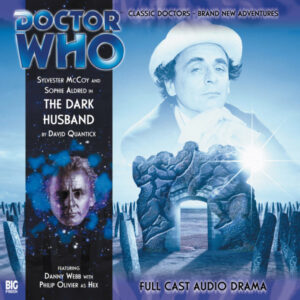 wedding.
wedding.
This is one where I didn’t remember liking it. It was too humorous, and not in a way that feels natural. Still, I’m re-listening to all of these and may change my mind as I go, but so far, my memories are matching up. And what do you know, another one that’s surprisingly not too bad.
The fourth part is really good with themes of duality shining through as things come together. It’s getting there that’s just okay. I found at least some of the humor on the juvenile side and wasn’t overly thrilled with the wedding stuff. So while this came together well and was enjoyable on the whole, it’s not one I’ll listen to again very often.
The highlights of this are McCoy who does quite well and guest actor Danny Webb who plays three different roles and does very well indeed. I’d rate this at 6/10 because it stuck the landing very well and was fairly enjoyable. As for Traveling the Vortex’s review of this story, see Episode #394 from August 2018.
After the mediocre Dark Husband, we have the other two releases that came out after the final end of Hex’s arc. As far as I can tell (all the timelines I looked at agreed on this), these two releases place here. I haven’t listened to either of them yet and until I listen to the CD Extras, this is as good a place as any, though there’s definitely a gap between Nocturne and The Dark Husband that they could fit in as well.
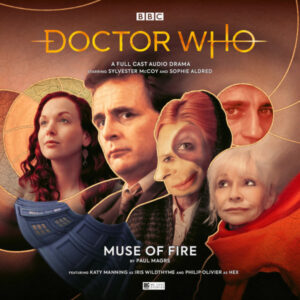 The first of these is Muse of Fire and features Seven, Ace and Hex meeting Iris Wildthyme and Panda. A disclaimer here, I haven’t actually listened to or read anything featuring Iris. I couldn’t get into The Wormery when I first tried it and just haven’t gotten around to anything else featuring her. (What? I do read things that aren’t Doctor Who. And, on top of that, there’s a lot of Doctor Who out there.)
The first of these is Muse of Fire and features Seven, Ace and Hex meeting Iris Wildthyme and Panda. A disclaimer here, I haven’t actually listened to or read anything featuring Iris. I couldn’t get into The Wormery when I first tried it and just haven’t gotten around to anything else featuring her. (What? I do read things that aren’t Doctor Who. And, on top of that, there’s a lot of Doctor Who out there.)
It’s an interesting story that’s somewhat humorous at times. Set in Paris, 1922, something is wrong with time as famous artists who were flocking to Paris at this time have been leaving. In the midst of this are Iris, art critic Panda and the mysterious Dora Muse. The Doctor, Ace and Hex arrive for a holiday and we meet Kevin Archer, an aspiring American poet and his wife Isabelle.
Everybody gets something to do in the story and the mystery is wrapped up well. Katy Manning does well as Iris and I really enjoyed Panda. That said, I don’t plan on going out and trying Iris’s adventures without the Doctor any time soon. She’s okay and enjoyable, but I didn’t really find her that fun. There are lots of other stories that I’ll hunt down before I’d even consider hunting down Iris. That said, if she happens to show up in another Doctor Who story, I won’t refuse to give it a try.
As for where this places in Hex’s run, all the CD Extras say is that it’s early but that we’re past the romance that had sort of been building between Ace and Hex and that they’re now in a more sibling relationship, so I’m fine with sticking this after The Dark Husband. I think I’d rate this a 7/10, good but not outstanding. As for Traveling the Vortex’s review of this story, as this was released after the initial run of Hex stories, they have yet to review this one.
The final release that came out after the end of the arc is The Flying Dutchman / Displaced. Just released in September 2020, I’ll try not to be too spoilery. The first story is The Flying Dutchman and it’s a simple tale. The Doctor and crew arrive on what seems to be an abandoned cargo ship in or around 1742. It turns out that the ship isn’t abandoned, but has instead seen the ghostly Flying Dutchman. I won’t go any further into story, but it’s a nice little mystery. The regulars all get things to do and it wraps up well.
The second story is Displaced. What we have here is essentially a haunted house story. The Doctor, Ace and Hex are considering another vacation after an unseen adventure featuring flammable fireflies controlled by an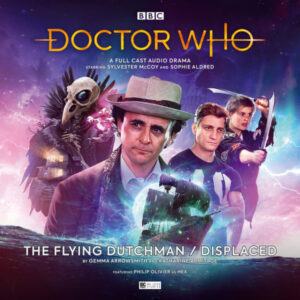 alien slug. When Ace goes to look at the database, the TARDIS seemingly crashes in a recently abandoned house and locks them out. It turns out the house is a smart house controlled by the latest AI, Harri and they’re in the Fenns in 2020. There’s a little bit where Hex mentions his time as if it’s a few years out instead of the next year saying something about this area having been all developed or something like that. (Wow, we’re coming up to the point of Hex being a present-day companion instead of near-future, a bit weird when you think about it.)
alien slug. When Ace goes to look at the database, the TARDIS seemingly crashes in a recently abandoned house and locks them out. It turns out the house is a smart house controlled by the latest AI, Harri and they’re in the Fenns in 2020. There’s a little bit where Hex mentions his time as if it’s a few years out instead of the next year saying something about this area having been all developed or something like that. (Wow, we’re coming up to the point of Hex being a present-day companion instead of near-future, a bit weird when you think about it.)
This is a nice haunted house story and in some ways has the feel of an escape room (never been to one, but I understand the concept). We get more into the personalities of Ace and especially Hex, both of whom accuse the Doctor of this being another test, though he’s as much in the dark as they are. It ends well and was rather enjoyable. The only major downside is that the alien’s voice is very hard to understand, especially at the beginning.
An enjoyable release, nothing really groundbreaking or arc-changing, but still an enjoyable listen. As a whole, I’d rate this release at 8/10 with The Flying Dutchman receiving a 7/10 and Displaced receiving a 8.5/10. As far as timeline placement, there’s still a slight hint of romance between Ace and Hex, but the teasing is much closer to a sibling relationship. The CD Extras don’t really give any further details beyond the fact that it’s after The Harvest (like that helps me any). As for Traveling the Vortex’s review of this story, as this was released after the initial run of Hex stories, they have yet to review this one.
After the sidestep into stories released after Hex’s departure, we return to the original run and begin the buildup towards what feels like the first big finale. First up is Forty-Five, an anthology of four single-part stories that have the number “45” as a motif running through them. The stories are “False Gods”, “Order of Simplicity”, “Casualties of War” and “The Word Lord”.
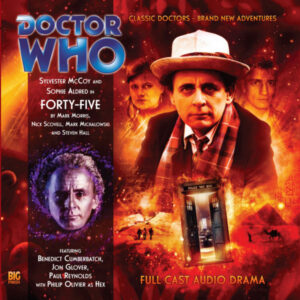 The first story is False Gods and sees Howard Carter unearthing the tomb of an Egyptian nobleman which will later be known as KV 45. One of the artifacts inside is a set of 45 Shabti statues, one of which holds special significance to the plot. This was a fun one and of special notice is Benedict Cumberbatch (Sherlock, Doctor Strange) as Howard Carter.
The first story is False Gods and sees Howard Carter unearthing the tomb of an Egyptian nobleman which will later be known as KV 45. One of the artifacts inside is a set of 45 Shabti statues, one of which holds special significance to the plot. This was a fun one and of special notice is Benedict Cumberbatch (Sherlock, Doctor Strange) as Howard Carter.
The second story, The Order of Simplicity, is set in a large house in 3380 where the titular order has released a virus that regresses those infected (including the Doctor) to an IQ of 45. It’s good, though I liked the previous story better. The virus can possibly be tied into the loose virus arc that is tied up (and given an origin) in the Sixth Doctor story Patient Zero.
The third story, Casualties of War, sees the Doctor, Ace and Hex chasing alien tech on VE Day, 1945. We discover that the thief has been stealing from The Forge, and also happens to live next door to Ace’s mum. Thus we get a continuation of Ace’s history from Curse of Fenric with Ace getting more closure, we also get a moment where the Doctor (under influence from the alien tech) almost reveals the fate of Cassie Schofield to Hex.
Finally, everything gets tied together in The Word Lord. This is the best story of the set by far and they’re all really good. The TARDIS arrives at a military base in Antarctica in 2045 at the height of the Second Cold War (see Warriors of the Deep) and are immediately accused of murdering one of the delegates here for a peace conference. Very soon, we are introduced to the true murder, Nobody No-One, a Word Lord from a dimension forty-five billion dimensions to the left of ours.
His ship, a CORDIS, hides itself as language and is only detectable by its emissions, in this case, the number “45” and its many variations (section 4.5, corridor 4 room 5, etc.). Nobody is a being with complete mastery over language just as the Doctor is a lord of time. Nobody gets his power from language, if someone were to say “Nobody can enter this base without clearance.”, then Nobody can do just that. This is a great story and Nobody is wonderfully fun villain. He definitely deserves a re-match with the Doctor, and the end of this story sets up the possibility.
Forty-five is a great anthology celebrating the 45th anniversary of Doctor Who. The stories are all really good and concise. And, they’re all fun. I’d rate this at a 9/10 with all but The Order of Simplicity getting a 10/10. Order gets a 9/10, but only because I just enjoyed the other three a little bit more. As for Traveling the Vortex’s review of this story, see Episode #421 from March 2019.
So, we have moved into the trilogy era of the Main Range. At the start of January 2009, the Doctor Who Main Rage began releasing trilogies. Previously, each release had featured a different Doctor (usually) and apart from the Eighth Doctor seasons were very loosely connected. Therefore, just to take a random sample, you’d have Five/Nyssa followed by Six/Peri followed by Seven/Ace followed by Six/Evelyn followed by Five/Peri/Erimem.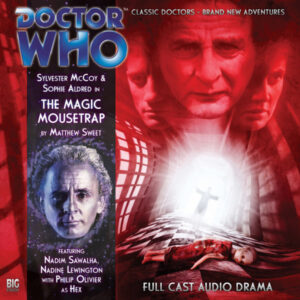
So starting in 2009 we started getting trilogies with the odd anthology or stand-alone release thrown in. For example, the first three trilogies were a solo Fifth Doctor trilogy focusing on the Key to Time, a Seven/Ace/Hex trilogy, an Eighth Doctor anthology single release and a Six/Charley trilogy that concluded Charley’s travels with the Doctor.
Our focus now is that first Seven/Ace/Hex trilogy which starts with The Magic Mousetrap. We start with an amnesiac Doctor in a cable car traveling to a sanatorium on a Swiss mountain. It turns out that the sanatorium is the realm of the Celestial Toymaker in his first return to performed media. The first half is quite confusing as the Doctor is in the dark while Ace and Hex are the chess masters. But then, things begin to slot into place and everything is revealed for a superb ending.
While it took a bit to get into, the Magic Mousetrap is a very good story with the second half really standing out as an exciting thriller. Note the chess sets that appear as they will be a signpost of things to come. I’d rate this an 8.5/10 because the first half is rather confusing but the second half pulls it up. As for Traveling the Vortex’s review of this story, see Episode #422 from March 2019. Also of note is that this audio also includes the first episode of The Three Companions “Polly’s Story” by Marc Platt at the end of Disc 2.
Next in line is Enemy of the Daleks and it’s Hex’s first encounter with the creatures. In the middle of the Dalek Wars, the Doctor, Ace and Hex arrive on the planet Bliss which the Doctor likens to the Galapagos Islands for biological diversity. Upon arrival, the Doctor tells Ace and Hex to stay in the TARDIS while he sorts things out. Ignoring his warnings, his companions follow him into danger.
 Meanwhile, a space battle between the Daleks and a refugee convoy occurs in a nearby star system. A ship containing a Valkyrie squad (a squad made entirely of female soldiers) flees the battle and arrives on Bliss. Both the Valkyries and the TARDIS crew come across a research station on the planet. Soon, the Daleks arrive as well.
Meanwhile, a space battle between the Daleks and a refugee convoy occurs in a nearby star system. A ship containing a Valkyrie squad (a squad made entirely of female soldiers) flees the battle and arrives on Bliss. Both the Valkyries and the TARDIS crew come across a research station on the planet. Soon, the Daleks arrive as well.
The Doctor knows what will happen here, a terrible atrocity. However, we discover over the course of the story that it’s a trap for the Daleks. A mad scientist has created a new species that, in their mature form, eat metal. These are to be used as a weapon against the Daleks.
This is the story that almost breaks Hex. The death and horrors he sees here make him feel helpless and wonder if this life isn’t for him. We also get almost a New Adventures soldier Ace here as the piece is very action-heavy. The Doctor suspects things but is quiet and reserved for the most part.
This is another really good story, very action-heavy with a lot of electric guitar in the soundtrack. The cast does well and Nick Briggs is excellent as the Daleks. I think I’d rate this at 8/10. As for Traveling the Vortex’s review of this story, see Episode #428 from May 2019. This release also includes the second episode of The Three Companions at the end of Disc 2. I’m not listening to these bonus stories for this review.
The final story of this trilogy is The Angel of Scutari and it carries on from the end of Enemy of the Daleks. An excellent engaging story that finds the Doctor, Ace and Hex in the midst of the Crimean War between Britain and Russia, known for the Charge of the Light Brigade. After the horror of the previous story, the Doctor brings Hex to Scutari where he can do some good with his medical training and regain some hope. Meanwhile, after reading a report, the Doctor and Ace go to Sevastopol, a few months prior.
What follows is a pure historical with appearances from famous historical figures like Florence Nightingale, Leo Tolstoy and Czar Nicholas I. The TARDIS is seemingly destroyed and the Doctor, Ace and Hex each get their stories placed against the backdrop of history.
stories placed against the backdrop of history.
There’s a bit of back and forth through time as Hex’s segments take place a couple of months after the Doctor and Ace’s. However, it seems to work here and make for a really enjoyable story. We learn that a school project on Nightingale coinciding with a career day is what caused Hex to choose the medical profession. The story ends with Hex getting shot in the shoulder and requesting to be taken home to St. Gart’s for treatment leading directly into the next story.
Angel of Scutari is a gripping historical set in the Crimean War. The cast does really well and all our leads get something to do. This story also introduces us to the White TARDIS. This is the state of the TARDIS for the next five Hex stories (and ties into most of the other Seventh Doctor Main Range stories released during this period). This is a great story that continues to show that the historicals are still worth making. I’d rate this at 10/10. There isn’t a Traveling the Vortex’s review of this story as Enemy of the Daleks is their most recently reviewed Seven/Ace/Hex story at this time. This release also includes the third episode of The Three Companions at the end of Disc 2.
The second Seven/Ace/Hex/trilogy starts off running with Project: Destiny. Here is where all the loose threads of Hex’s arc seem to coalesce. Despite being released a year-and-a-half after Angel of Scutari, we pick right with the Doctor and Ace bringing Hex to St. Gart’s to take care of him after he got shot in Scutari. However, we find ourselves in an abandoned London.
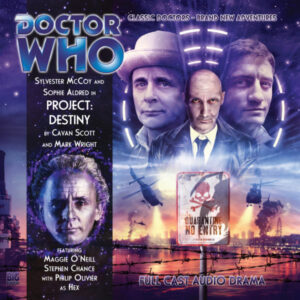 This is the final installment in the Forge/Project trilogy after Project: Twilight and Project: Lazarus. As such, it brings the Forge, which has been lingering in the back of the Hex arc after appearances in No Man’s Land and Forty-five: Casualties of War, front and center. It also brings the fate of Hex’s mother into the foreground in the worst possible way.
This is the final installment in the Forge/Project trilogy after Project: Twilight and Project: Lazarus. As such, it brings the Forge, which has been lingering in the back of the Hex arc after appearances in No Man’s Land and Forty-five: Casualties of War, front and center. It also brings the fate of Hex’s mother into the foreground in the worst possible way.
It has the feel of a zombie/contagion movie with lots of action as London is a quarantine zone because an insectoid hive-mind species has begun infecting the population and have overrun London. We meet Forge operative Lysandra Aristedes who will be returning later. Nimrod has been rebranded as Dr. William Abberton and is the head of Department C4, the Forge’s public face.
In the midst of all this is Hex who is caught between the Doctor and Nimrod. The confrontation that leads to the Episode 3 cliffhanger is highly emotional and really good. And then, there’s the return of Cassie Schofield in Part 4. After a roller coaster of a story, Hex quits and leaves the TARDIS. Then, as the Doctor and Ace prepare to leave, Lysandra mentions that there’s a sarcophagus with the Seal of Rassilon (confirming that we now have the TV Movie console room) buried in the Forge archives which leads into the next story.
I found this to be a really fun story that really puts Hex through the emotional ringer. Everyone gets stuff to do and the actors get lots of stuff to sink their teeth into. Nimrod again is a superb villain and works really well against McCoy’s Seventh Doctor. The only downside is that this isn’t a story to jump on with. Maybe on a second listen, but there’s definitely homework that is required. I would suggest that you at least need the two other “Project” stories that form a trilogy with this, and The Harvest, and at least Angel of Scutari if not Enemy of the Daleks too. Beyond that, there’s a coda to the story Thicker Than Water that is primarily a Six/Mel/Evelyn story that’s heavily referenced in the CD Extras for this. All said though, I’d rate this 10/10.
The next story, A Death in the Family, deals with the fallout from the revelations of the previous story. This review will be heavy in spoilers because I can’t talk about it without them. Without spoilers, this would be one paragraph telling you to go listen to this story. Anyway, let’s dive into this.
The Gallifreyan sarcophagus contains a future Seventh Doctor who has managed to defeat the Word Lord Nobody No-one. By recovering this Doctor, Nobody is freed and ends up killing the Doctor. The next two episodes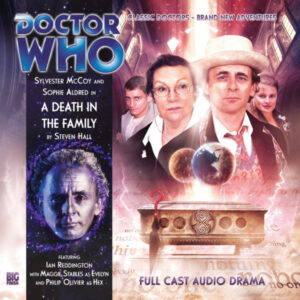 focus first on Hex who has been taken to a planet in the distant past where Evelyn has ended up and then on Ace as she tries to fix things while falling in love. The final episode brings these threads together for a heart-wrenching finale.
focus first on Hex who has been taken to a planet in the distant past where Evelyn has ended up and then on Ace as she tries to fix things while falling in love. The final episode brings these threads together for a heart-wrenching finale.
So that’s the story. Now, let’s break this down a little. First, Nobody has regenerated into Ian Reddington (known as the Chief Clown from Greatest Show in the Galaxy) who is wonderful as the Word Lord. Manic, twisted, a joy to listen to. He feels a lot like Mark Hamill’s Joker here. Second, Hex gets a chance to heal thanks to learning the truth about his mother from someone who isn’t playing games with him caught in the middle. The Doctor wins thanks to some really clever writing that I won’t spoil here. But the cost of the victory is heart-breaking. Even knowing it was coming, I was tearing up. So the big SPOILER is, that Evelyn dies! She does so in a wonderfully heroic way that Maggie Stables delivers to perfection. Listening to Evelyn and Nobody going head to head is a wonderful scene. But, it’s still a final end to the character of Evelyn Smythe complete with a funeral, which is made even harder with the passing of Maggie Stables.
A Death in the Family is a wonderful, excellent story. Everybody shines in it and it works so well as a season or even series finale. If this had been the final end of the Hex Arc, I would’ve been perfectly happy. Yes, Hex leaves with the Doctor and Ace at the end, but this still could’ve been a great endpoint. I’d rate this at 10/10.
Now, we start the next Seven/Ace/Hex arc, the Elder Gods arc. It’s already been in the background a little bit I’m told. The White TARDIS continues in this arc culminating with Black and White. There are also stories in this Elder Gods arc that aren’t part of the Hex arc (such as House of Blue Fire) and as such won’t be reviewed here.
The other main thing going forward is that apart from two stories in the final trilogy of the Hex arc, all of these will be brand new experiences for me. I know some of the arc’s plot points, but haven’t actually listened to any of these. A Death in the Family was where I dropped away from the Hex arc because of life and the fact that other stories caught my interest. Yes, availability was a big part of it at the time, but once availability wasn’t a factor, I still never made it back to these.
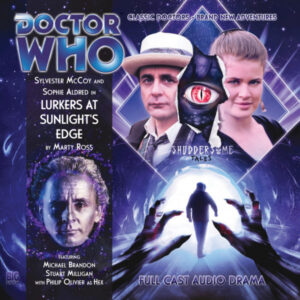 With that out of the way, we have Lurkers at Sunlight’s Edge. Lurkers finds the Doctor, Ace and Hex still in the White TARDIS, landing in 1934 Alaska on an island that shouldn’t exist. The story revolves around releasing ancient monsters that pre-date history, the Karnas’koi.
With that out of the way, we have Lurkers at Sunlight’s Edge. Lurkers finds the Doctor, Ace and Hex still in the White TARDIS, landing in 1934 Alaska on an island that shouldn’t exist. The story revolves around releasing ancient monsters that pre-date history, the Karnas’koi.
In essence, this is a straightforward adventure in which Doctor Who does HP Lovecraft. I’ve never delved into Lovecraft. Yes, I’ve heard of Cthulu, but these stories have never piqued my interest. However, that said, the Cthulu Mythos has seemed to have been entangled with Doctor Who. If I understand things, at some point the “Great Old Ones” of Lovecraft has become equated with various Doctor Who monsters such as the Animus, the Great Intelligence and above all, Fenric. If Tardis Wiki is to be believed, this happened during the Virgin era.
As for this story itself, it’s really enjoyable. Not necessarily something I’d return to often, but still quite enjoyable. Going into this knowing in basic strokes the arc going forward might affect it, I don’t know. Anyway, I’d rate this at 8/10.
So we come to Protect and Survive, the first of the second-to-last Seven/Ace/Hex trilogy. This is the “Elder Gods” trilogy in that, after the preview in the previous story, the Elder Gods are front and center. It also continues the “White TARDIS” arc that’s been going on since Angel of Scutari. Finally, it’s also notable that the Doctor barely features in this story. He doesn’t make an appearance until Part 2. That’s because this was recorded at the same time as the Hobbit was being filmed.
So, the story. This was an interesting one. Ace and Hex are dropped off in a timeline where, instead of the Soviet Union collapsing in 1989, World War 3 breaks out with a nuclear strike. Seemingly abandoned by the Doctor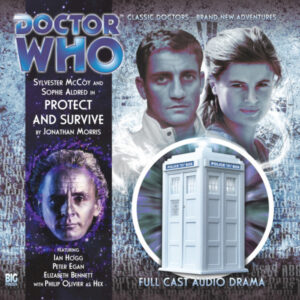 and TARDIS, they meet an elderly couple Albert and Peggy Marsden and get caught up going through the motions of “Protect and Survive”, a pamphlet that in the real world was never distributed. It turns out that Albert and Peggy are Elder Gods (like Fenric) that are trapped in a pocket dimension after the Doctor stopped them from changing history and destroying the Earth. The pocket dimension is a two-week time loop of the start of nuclear war so that “Albert” and “Peggy” can learn to be human.
and TARDIS, they meet an elderly couple Albert and Peggy Marsden and get caught up going through the motions of “Protect and Survive”, a pamphlet that in the real world was never distributed. It turns out that Albert and Peggy are Elder Gods (like Fenric) that are trapped in a pocket dimension after the Doctor stopped them from changing history and destroying the Earth. The pocket dimension is a two-week time loop of the start of nuclear war so that “Albert” and “Peggy” can learn to be human.
The first half is your standard nuclear war story, though things begin to fall into place that something else is going on here. The second half is where it gets a bit more weird and frantic and where the Elder Gods really come into play as the background of why this is happening is revealed. The ending has the TARDIS return for Ace and Hex, though this time it’s black. Inside isn’t the Doctor, but instead Lysandra (from Project: Destiny) and new companion Sally Morgan (introduced in House of Blue Fire).
It’s a good story, dark and bleak, but good. It’s not a favorite but was still a worthwhile listen. It’s confusing at first but acts as an interesting look at what could have been historically. The Black TARDIS has made appearances previously in Robophobia, The Doomsday Quatrain and the aforementioned House of Blue Fire. Because they don’t feature Hex, I don’t plan on reviewing them here (this is already long enough as it is). And, as best I can tell, the only one that ties into the Elder God arc is House of Blue Fire. Anyway, I’d rate this at 7/10.
Next up is Black and White, which sees the two sets of companions set off to find the Doctor who has apparently gone to meet Beowulf. We get a rough account of the Doctor’s crusade against to Elder Gods through flashbacks of his adventures with Lysandra and Sally. We also learn a bit about the Black and White TARDISes, and the previous Seventh Doctor trilogy (which were companionless and seemed to me to be toward the end 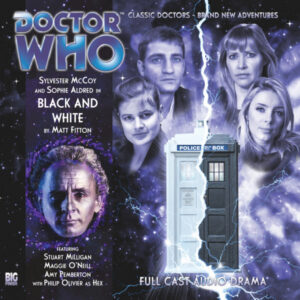 of Seven’s life) were test runs of the newly minted Black TARDIS.
of Seven’s life) were test runs of the newly minted Black TARDIS.
The main story continues on from the end of Protect and Survive where the Black TARDIS arrives to pick up Ace and Hex with Lysandra and Sally (played by Amy Pemberton: Gideon from DC’s Legends of Tomorrow) on board. From there, Sally and Hex end up in the White TARDIS while Ace and Lysandra end up in the Black TARDIS. Both follow the Doctor to meet Beowulf but end up sixteen years apart.
This was an enjoyable story. Garundel, a toad-like alien who serves as the inspiration for Grendel in the Beowulf legend, is really fun. The character interactions between the companions is good and the Beowulf stuff is fine. However, where this becomes important is setting up the next story with the Companions retrieving Weyland’s Shield. There’s even a clue to the true villain of the trilogy in the name Beowulf. I won’t spoil it here (though I definitely will in the next entry), but if you think through with a mind toward the Elder Gods and the Seventh Doctor, you should get it easy enough.
This story was fine. But, what with it acting as a bridge and buildup, and having all the flashbacks, it’s not as good as a stand-alone story as it is part of a trilogy. Be aware that there’s a post-credits scene between the credits and the CD Extras. I’d rate this at a 7/10.
The current trilogy concludes with Gods and Monsters. Having used Weyland’s Shield to find the Doctor, the four companions find themselves on a giant game board hovering in space. The game board is a battlefield littered with Saxons and Vikings, and soon an army of Haemovores is marching towards them.
I won’t go deep into plot details for the bulk of the story. Needless to say, the main villain is Fenric who has been playing this game since at least the Magic Mousetrap. It’s a good story, though a bit hard to follow at times. It’s littered with chess references, as expected with a story featuring Fenric. Fenric is battling another Elder God, Weyland, for control of the shield, and the Doctor and friends are just pawns in the game.
This is an enjoyable story with a lot going on. It requires that you have at least listened to the previous two stories and watched the Curse of Fenric, to understand this. It helps to have listened to all the previous Hex stories as well with Angel of Scutari and the Magic Mousetrap getting a mention.
However, the end of Episode 4 is worth the entire story. And here I will be presenting major spoilers. Hex is Weyland’s pawn, who as planned is to use the shield to destroy Fenric. Even the Forge figures into the game as Weyland’s creation. However, Hex turns the shield’s power against Weyland, at which point Fenric disappears. Because Weyland has been destroyed, Hex’s wound from Scutari, which Weyland had fixed, begins bleeding again and Hex is rushed into the TARDIS. We soon find that Hex is possessed by Fenric. However, Hex sacrifices himself to defeat the monster. This handful of scenes is worth picking up this story just for this alone.
Gods and Monsters is an enjoyable story. Good acting and, for the most part, good effects. Had this been the end of Hex’s story, I would’ve been fine with it. However, there are still four more stories and this one has a post-credits scene leading into the next one. I did rewatch Curse of Fenric in the midst of my listening to this. I would’ve rated this a 9/10 because there are some confusing bits and the chess references get a bit old. However, because of the ending, I rate this a 10/10.
Fifteen months after Hex’s death in Gods and Monsters, we get Afterlife, a solitary release sandwiched between trilogies in December 2013. This story deals with the fallout of Hex’s death. The first episode is entirely made up of the Doctor and Ace working through their grief mixed with a letter Hex wrote to his Nan probably just before Live 34 that features flashbacks to an unseen adventure. And it’s brutal. I was on the verge of tears at times with Sophie and Sylvester giving excellent performances. In the end of this first episode, Ace will only accept the Doctor’s apology if he mails the letter and then, once the letter  has arrived, deliver news of Hex’s death like a good Commanding Officer should at the death of a soldier.
has arrived, deliver news of Hex’s death like a good Commanding Officer should at the death of a soldier.
So while the Doctor does as Ace asks and delivers the bad news to Hilda Schofield, on New Year’s Eve of all days, Ace stays in the TARDIS. We get some lovely acted scenes between the Doctor and Hilda who go to a wake that the Doctor’s set up, where Sally Morgan happens to show up. Meanwhile, Ace gets involved in a gang war between Lily Finnegan, a fire-elemental and a “Mister Thomas”. At the end of Episode 2, after a confrontation between the two gang leaders, Ace comes face to face with Mister Hector Thomas, who is in fact Hex.
It turns out that Hex survived, sort of, and won a lot of money playing cards in the Afterlife. He then cashed it in for a year of life on earth, however, he didn’t get to keep his memories. Instead, it appears they were stored and sent with him. The climax, a battle with Lily Finnegan, is actually not bad. It appears that Hex’s memories are lost forever leaving Hector a clean slate. The Doctor and Ace take Hector with them in the TARDIS, setting up the next trilogy, while Sally stays in Liverpool with Hilda.
This isn’t a bad story. The first episode is outstanding and the interactions between the Doctor and Hilda are really good. Unfortunately, I wasn’t that into the gangster subplot with Mrs. Finnegan. Yes, this was needed for Ace and the Doctor, but the whole Hector Thomas trilogy feels like an add-on that overstayed its welcome. I’d rate this at 7/10 with Episode 1 bumping it up from a lower score.
And so we begin the final Hex trilogy. Revenge of the Swarm acts as both a Sequel and Prequel to the TV story “The Invisible Enemy”. When Hector touches the console while the Doctor and Ace are outside, he ends up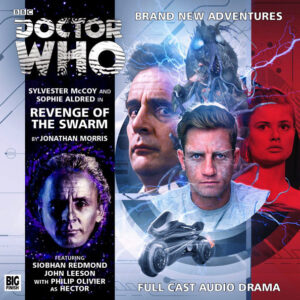 contracting the Swarm, which has lain dormant in the TARDIS since the Fourth Doctor’s time. Under the influence of the virus, he sets the TARDIS in motion to coordinates that lead to Titan.
contracting the Swarm, which has lain dormant in the TARDIS since the Fourth Doctor’s time. Under the influence of the virus, he sets the TARDIS in motion to coordinates that lead to Titan.
This is a surprisingly fun story. The biggest problem is that I never really cared that much for the Invisible Enemy. So, while this story clips along at a decent pace, my indifference towards its parent story keeps me from truly enjoying this one. We get to look a little bit deeper into Hector, who having lost the Hex part of himself, is more susceptible to the swarm’s influence.
The other problem I have, apart from the ties to Invisible Enemy, is that once things get going Hector doesn’t really seem very different from Hex. Whereas in Afterlife, he was a hardened gangster and his accent was slightly different, here he often sounds just like regular Hex.
All that aside, the scenes with the Doctor and Ace in a computer confronting the Nucleus of the Swarm are really fun, though the sound effects are a bit noisy. And, John Leeson does an excellent job hamming it up as the Nucleus. In all, this was enjoyable though kinda a rehash of the original story. I rate it at 6/10, though some of that is my indifference to the original and my not finding Hector that great a character.
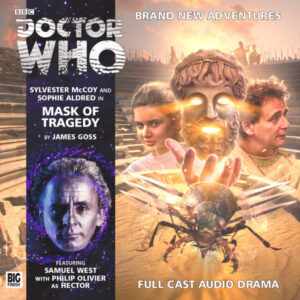 The penultimate Hex story, Mask of Tragedy sees the Doctor, Ace and Hector arrive in Athens, 421 BC to see the theater. This is the final Hex story that’s new to me. Because Ancient Greece isn’t a huge draw for me (as opposed to say, Ancient Egypt), I was a bit ambivalent towards the lukewarm start. However, as the story progressed, I found myself enjoying it more.
The penultimate Hex story, Mask of Tragedy sees the Doctor, Ace and Hector arrive in Athens, 421 BC to see the theater. This is the final Hex story that’s new to me. Because Ancient Greece isn’t a huge draw for me (as opposed to say, Ancient Egypt), I was a bit ambivalent towards the lukewarm start. However, as the story progressed, I found myself enjoying it more.
Essentially, the plot revolves around the Doctor sponsoring plays by Aristophanes and his rivalry with Cleon, the ruler of Athens. Meanwhile, a strange plague is haunting the city and the Spartans are at the gates of the city. Now, this would all make for an enjoyable historical. However, in the midst of this is the fact that Athens is a very popular travel destination for time travelers and everyone knows it.
As such, one visitor is a giant, alien beetle. And here lies the bulk of the story as the beetle’s mask (which allows him to blend in) is on the fritz and ends up being used by Hector to try and fix things before falling into the hands of Cleon. Meanwhile, Ace is ostracized from the city and ends up joining the Spartans where she leads a female battalion into the city.
This isn’t a terrible story and gets better as it progresses. That said, it wasn’t spectacular and was stuck between trying to be a comedy and a serious drama. Hex seemed to go back and forth between sounding like the old Hex and being Hector. Otherwise, while I enjoyed the story, in the end, it only gets a rating of 6.5/10.
Finally, we have Signs and Wonders. After their adventure in Greece, Hector demands the Doctor take him home to Liverpool. However, the TARDIS arrives two years later at the End of Days. Hilda has passed and Sally is looking to rejoin the military, a reality TV star turned prophet named Rufus Stone is holding raves in the streets, and people are seeing their own deaths in their dreams.
This is a loud, noisy audio. The first half is a bit confusing as the pieces are laid. Rufus Stone is in reality an agent of the Aquillians, an alien race that looks like Eagles, who are using the psychic power of the crowds to summon interdimensional alien leeches called Hirudines. There’s a lot going on here so that it’s confusing at first. However, in amongst the action, we get the conclusion to the Hex/Hector arc and the conclusion of the Elder Gods arc.
Gods arc.
So there’s an ancient Elder God named To’koth who, having grown tired of the fighting among the other, younger Elder Gods, moved to Liverpool and went to sleep beneath it. Now he’s dying and several parties want to absorb his powers. The Aquillians consider To’koth their god and thus his power to be theirs. Then there’s Ginny Greenteeth.
Introduced early in the story as Vicar Janet Green, Ginny is another Elder God. She wants Ko’koth’s power for herself. Seemingly killed off early on, she suddenly reappears and ends up in a battle with Hex/Hector. It turns out that Hex’s memories weren’t lost but instead stored in his St. Christopher medal that Sally had hung onto. Ginny is defeated and To’koth is taken back to his dimension to die, an act that creates a truce between the Doctor and the Elder Gods. Hex then stays on Earth with Sally where they settle down. We then get a nice coda set 15 years later where Ace and the Doctor say goodbye to Hex before reiterating the ending of Survival.
And so ends the Hex arc. While the first half of this final story was a loud, chaotic mess, the second is quite enjoyable. Hex gets a really good finale. I’ll go into more of my thoughts on Hex in a bit, but I was kinda mixed on this story. The first half is kinda meh for me but the second half was quite good. Therefore, I’ll give this a rating of 8/10.
So, while Hex’s arc is focused in the audio stories of the Monthly Adventures, Hex also features in six Short Trips from the print collections from Big Finish. These are spread out across five collections. The first is These Things Take Time by Samantha Baker from the collection Short Trips: Monsters. The next is found in the collection Short Trips: A Day in the Life and are Six Impossible Things Before Breakfast by Dan Abnett and The Heroine, the Hero and the Megalomaniac by Ian Mond. The second of this pair also features Eight and Charley who are actually the primary protagonists. I think I’ve read these two because their descriptions sound vaguely familiar.
 |
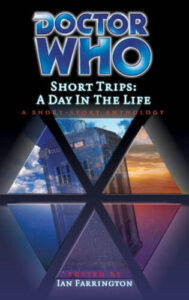 |
After these, we have three more, each from a separate collection. First, we have Presence by Peter Anghelides from the collection Short Trips: The History of Christmas. Reading the plot on Tardis Wiki, this one seems rather sweet. Next is Natalie’s Diary by Joseph Lidster, a four-part story from Short Trips: Dalek Empire. Finally, we have The Report by Gary Russell from Short Trips: Snapshots. I know I haven’t read any of these. I include these for the sake of completion and am a little surprised that Hex hasn’t featured in any of the audio short trips from Big Finish.
The Main Cast
Right. So, we’ve made it through all the Hex stories and taken a look at each of them. Let’s take a look at the main cast members. First up, the Seventh Doctor. I love the Seventh Doctor. I don’t know why, maybe it’s just the strength of his stories or his scheming plotting nature. Maybe it’s just the Scottish accent and rolling “R”s. Or maybe it’s the spoons. I just don’t know.
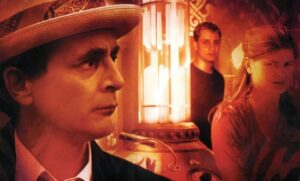 While the New Adventures are said (I haven’t read that many of them, or very many that recently, so I can’t say from personal experience) to take the scheming, chess-master as far as it could go, the Big Finish stories seem to find a more balanced take on this incarnation. I’ve seen reviews (primarily from the blog Doc Oho) that state that the screaming Seven and Ace don’t work well, especially on audio. Part of me agrees, but then there are times, like the finale of LIVE 34, where it works so well.
While the New Adventures are said (I haven’t read that many of them, or very many that recently, so I can’t say from personal experience) to take the scheming, chess-master as far as it could go, the Big Finish stories seem to find a more balanced take on this incarnation. I’ve seen reviews (primarily from the blog Doc Oho) that state that the screaming Seven and Ace don’t work well, especially on audio. Part of me agrees, but then there are times, like the finale of LIVE 34, where it works so well.
Over the course of this arc, while we see the scheming chess-master, we also get instances where the Doctor’s just as much in the dark as his companions. We also get quiet, tender moments where we see the Doctor is still vulnerable despite his mysterious aura and secretive persona. I think it comes down to both the writing and the acting where you can have great acting bringing up a mediocre script and mediocre acting bringing down a great script.
When McCoy is good, he’s excellent. When he’s just okay, he’s just okay. I think that, unlike say Colin Baker or Paul McGann who can liven up even the most average script, McCoy doesn’t quite have that ability. But, that said, I still love McCoy’s Doctor and usually enjoy his stories. As far as seeing him in roles outside of Who, I’ve seen him in the Hobbit, that’s it. I enjoyed his small role, but otherwise can’t really comment much.
Next, we have Ace. So, Seven and Ace are one of my favorite TV TARDIS Teams. They work so well together and Ace actually feels like a person unlike say Mel who was supposed to be a computer programmer but becomes just a cardboard cutout that is primarily a fitness fanatic and a screamer. Ace meanwhile gets a fleshed-out backstory and an actual story arc.
On audio, we’ve had TV Ace, New Ace (a battle-hardened war veteran from the Virgin New Adventures) and something in between. And yet, there are times when Ace doesn’t seem to have changed much. I agree with reviews that I’ve read (primarily Doc Oho again) that older Sophie Aldred can’t match the younger screaming Ace anymore, and I think that’s true for the most part. There are occasions where it works, but there are more where it doesn’t quite work.
When we first meet Hex, Ace is going by McShane. This is because of the events of the previous two Ace stories (Colditz and the Rapture). The first affects Ace a lot with definite emotional abuse and seeing a man die in a gruesome way. The second finds Ace meeting her lost younger brother. (I’ve already reviewed these so I won’t go any deeper.)
Hex gives Ace someone to gang up on the Doctor with. While there are inklings of a romance between Ace and Hex early on, this relationship evolves into something more akin to siblings. Ace ends up becoming a mentor to Hex. When Hex dies, it affects Ace immensely giving us an excellent first episode of Afterlife.
to Hex. When Hex dies, it affects Ace immensely giving us an excellent first episode of Afterlife.
After Hex’s final departure, Ace continues to travel with the Doctor and wonderfully paraphrases/reiterates the Doctor’s speech at the end of Survival. During the conclusion of Signs and Wonders, both Ace and the Doctor get visions of their deaths/futures. The Doctor of course gets Madame Butterfly in some sort of theater. Ace meanwhile gets three: her wearing a high collar, riding a motorbike in Paris in the 19th century and being surrounded by “three giant fleas”. These represent her departures in Big Finish (joining the Time Lords), the Virgin New Adventures (see the novel “Set Piece”) and the Doctor Who Magazine comics (see the story “Ground Zero”). Whether this is intended to be three different timelines or just as an easter egg to fans in the know, I don’t know. All that said, Ace still works well in these for the most part and is still one of my favorite companions.
And so we come to Thomas Hector “Hex” Schofield, a London nurse from Liverpool. Originally a near-future companion from 2021. Wow, I still can’t get over the fact that Hex’s native time is THIS year. Hex starts out as your average bloke thrown off into the deep end in his first adventure.
He joins the Doctor of his own volition and doesn’t look back. Then he’s pulled through the wringer as he goes on his travels. Cromwell, the hate room, Nimrod, the Word Lord, Fenric. He had a good run and his arc finales (Project: Destiny/A Death in the Family, Gods and Monsters, and Signs and Wonders) are outstanding. He’s just a very likable character.
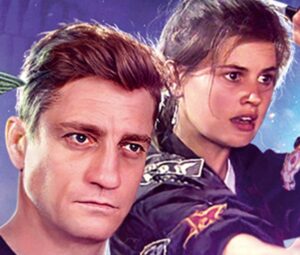 I think the only place where his arc falls down is in the Hector trilogy and the Hex stories released post-Signs and Wonders. After such an amazing end in Gods and Monsters, did we really need more? Maybe. Probably not. Yes, I know I’ve referencing Doc Oho a lot here, but he often makes some good points. One is that Big Finish possibly kept the Hex arc going because they liked working with the actor Philip Olivier so much. I don’t know, it’s possible.
I think the only place where his arc falls down is in the Hector trilogy and the Hex stories released post-Signs and Wonders. After such an amazing end in Gods and Monsters, did we really need more? Maybe. Probably not. Yes, I know I’ve referencing Doc Oho a lot here, but he often makes some good points. One is that Big Finish possibly kept the Hex arc going because they liked working with the actor Philip Olivier so much. I don’t know, it’s possible.
The majority of the Hector arc was lackluster to me. Afterlife wasn’t terrible and the first episode was worth the price. Revenge of the Swarm wasn’t terrible, it just happened to be a prequel/sequel to a story I’m not terribly fond of. Mask of Tragedy was just kinda there at first but ended well enough. And Signs and Wonders had an okay first half but then a really strong second half that wrapped up a lot. The biggest issue was that there wasn’t often a clear difference between Hex and Hector, which in turn made the choice to have a technically new character kinda moot. As for the three post-Signs and Wonders releases, they were enjoyable, just nothing super amazing.
So, that wraps up my thoughts on Hex as a character. He’s still a favorite of mine and one that works well and has a well-defined arc, even if (as stated in the CD Extras) some of it was made up as they went along. As for seeing Philip Olivier in anything outside of Doctor Who, I haven’t to my knowledge seen anything with him in it.
Final Thoughts
So, after four months and 26 releases, I’ve finished the Hex arc. While this seemingly took forever, it was worth it. There were more good stories than bad and even then, most of the lower-rated ones were middling or average as opposed to truly bad. I enjoyed the arc and while there were middling stories, the high points were really high.
There are plenty of stories in this arc that I’d go back and re-listen to. And Hex is an enjoyable character that is just fun to listen to. He melds well with the Doctor and Ace as a team. Out of curiosity, I went and averaged my ratings for the stories above and came out with an 8/10.
Are there returning villains or concepts from this arc that I’d like to see a return in some form? I don’t know. I’m kinda done with the Elder Gods at this point. Maybe seeing Fenric come back on TV, but I’d be fine if he doesn’t return. The Word Lord might be cool to see, but he’s another who had a complete arc and a final end.
Maybe a TV story with Cromwell could be interesting, but I don’t think the TV series could do it as well as The Settling. I wouldn’t mind seeing Iris Wildthyme and Panda show up on TV, but unless done really, really well, I don’t see that working. The only other thing I could see returning in some form is the Forge. I’d love to see a three-way confrontation between UNIT, Torchwood and the Forge on TV (or audio, books or comics, I’m not picky). That might be fun.
So that’s it for this Companion Archive. Hex was an enjoyable companion and this gave me an excuse to listen to all these, especially the ones I hadn’t gotten to yet. I look forward to hearing the Guys’ thoughts on the rest of these stories whenever they get around to them. I’ve got a few ideas for what I might do next for one of these, but I’m not going to tell you what they are right now. SPOILERS!!! Anyway, that’s it. If you want to discuss anything about these stories, be sure to check out the Traveling the Vortex Listener’s Forum on Facebook.
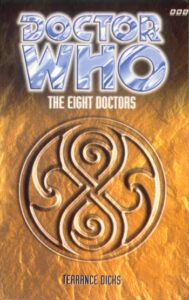 The first book we have (not counting the novelization of the film which is sometimes stuck in this list) is The Eight Doctors by Who veteran Terrence Dicks. We pick up right after the TV Movie with the Doctor reading The Time Machine. Soon, however, he falls into a trap set by the Master in the Eye of Harmony that gives the Doctor amnesia, again, beginning a surprising motif that seems to reoccur off and on throughout the Eighth Doctor’s life.
The first book we have (not counting the novelization of the film which is sometimes stuck in this list) is The Eight Doctors by Who veteran Terrence Dicks. We pick up right after the TV Movie with the Doctor reading The Time Machine. Soon, however, he falls into a trap set by the Master in the Eye of Harmony that gives the Doctor amnesia, again, beginning a surprising motif that seems to reoccur off and on throughout the Eighth Doctor’s life.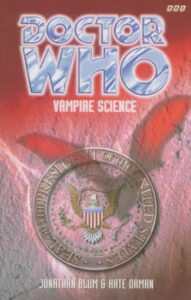 Next, we have Vampire Science, written by Kate Orman and Jonathan Blum, which sees the Doctor and Sam hunting vampires in San Francisco. We start in 1976 where the Doctor kills a Vampire and in the process meets Carolyn McConnell, a student who wants to cure cancer. Then we jump to 1997 where the bulk of the story takes place. The Doctor, Sam, Carolyn and Brigadier-General Adrienne Kramer of the US Branch of UNIT, work together to bring down a coven of Vampires that, as the novel progresses, are on the verge of civil war. The leader of the vampires, a 900-year-old vampire named Joanna Harris, is also working at finding a substitute food source. A lot is going on in this novel, but despite all that, it’s a really fun read. The authors nail the Eighth Doctor’s energy and voice. I could easily hear McGann in the dialogue. A great accomplishment considering all they had was the TV Movie.
Next, we have Vampire Science, written by Kate Orman and Jonathan Blum, which sees the Doctor and Sam hunting vampires in San Francisco. We start in 1976 where the Doctor kills a Vampire and in the process meets Carolyn McConnell, a student who wants to cure cancer. Then we jump to 1997 where the bulk of the story takes place. The Doctor, Sam, Carolyn and Brigadier-General Adrienne Kramer of the US Branch of UNIT, work together to bring down a coven of Vampires that, as the novel progresses, are on the verge of civil war. The leader of the vampires, a 900-year-old vampire named Joanna Harris, is also working at finding a substitute food source. A lot is going on in this novel, but despite all that, it’s a really fun read. The authors nail the Eighth Doctor’s energy and voice. I could easily hear McGann in the dialogue. A great accomplishment considering all they had was the TV Movie.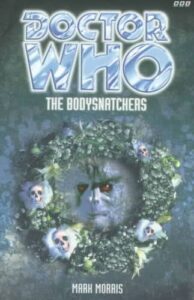 Third in line is The Bodysnatchers by Mark Morris. This novel sees the Doctor and Sam up against the third returning monster in a row: the Zygons. (This after the Time Lords, and the Master, in The Eight Doctors and then Vampires.) When the Doctor arrives in 1894 London to replace a damaged magazine, he and Sam stumble on a man scared out of his mind who is soon eaten by a monster. Teaming up with George Litefoot (and not Henry Gordon Jago), they discover a genocidal Zygon plot.
Third in line is The Bodysnatchers by Mark Morris. This novel sees the Doctor and Sam up against the third returning monster in a row: the Zygons. (This after the Time Lords, and the Master, in The Eight Doctors and then Vampires.) When the Doctor arrives in 1894 London to replace a damaged magazine, he and Sam stumble on a man scared out of his mind who is soon eaten by a monster. Teaming up with George Litefoot (and not Henry Gordon Jago), they discover a genocidal Zygon plot. So, while not quite as enjoyable as the previous novel, it’s still a good read. It just takes a bit longer to really get going. This is a good Doctor Who novel, maybe not great, but still really good. Though, as I work my way through these, I’m looking forward to original monsters and new villains. As with the previous two, I have managed to read this before. In the end, I think I’d rate this at 7/10.
So, while not quite as enjoyable as the previous novel, it’s still a good read. It just takes a bit longer to really get going. This is a good Doctor Who novel, maybe not great, but still really good. Though, as I work my way through these, I’m looking forward to original monsters and new villains. As with the previous two, I have managed to read this before. In the end, I think I’d rate this at 7/10. Fifth in line is War of the Daleks by John Peel. This is a book that is very controversial to the point where it was disowned by at least some parts of fandom. Apparently, John Peel (and according to him, Terry Nation) really disliked the resolution of Remembrance of the Daleks and the destruction of Skaro. To try and erase Remembrance from canon, Peel went and retconned the televised Dalek stories especially Destiny through Remembrance. Peel had already gotten flak for Timewyrm: Genesis, primarily the sexuality issues, but this was seemingly worse.
Fifth in line is War of the Daleks by John Peel. This is a book that is very controversial to the point where it was disowned by at least some parts of fandom. Apparently, John Peel (and according to him, Terry Nation) really disliked the resolution of Remembrance of the Daleks and the destruction of Skaro. To try and erase Remembrance from canon, Peel went and retconned the televised Dalek stories especially Destiny through Remembrance. Peel had already gotten flak for Timewyrm: Genesis, primarily the sexuality issues, but this was seemingly worse.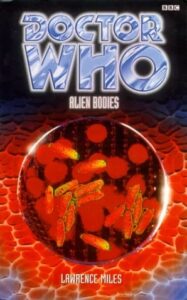 Finally, in the hope of keeping this article short and manageable, we have Alien Bodies by Lawrence Miles. This is the novel that launched several of the threads that would persist through at least the first half of the series. It’s also one of the first Doctor novels I read, and where I’ve dropped off the EDAs in the past. My dilemma here is how much do I spoil as this book in some ways relies on its surprises. But, as it is twenty-four years old, I think I’ll risk it.
Finally, in the hope of keeping this article short and manageable, we have Alien Bodies by Lawrence Miles. This is the novel that launched several of the threads that would persist through at least the first half of the series. It’s also one of the first Doctor novels I read, and where I’ve dropped off the EDAs in the past. My dilemma here is how much do I spoil as this book in some ways relies on its surprises. But, as it is twenty-four years old, I think I’ll risk it.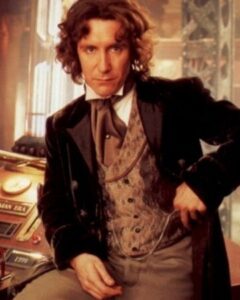 So how is the main cast so far? Let’s start with the Eighth Doctor. First of all, for just having the TV Movie to work, the authors seem to have done quite well. From my perspective, it feels like McGann’s Doctor: full of energy and a love for life. He makes things up as he goes along. The problem I’m personally having is whether the authors are actually doing a good job, or if my familiarity with the Eighth Doctor on Big Finish is making it seem like they’ve done a good job. If anything, the Doctor is at his most generic in The Eight Doctors, especially in the first two interactions with the past incarnations. That said, it feels like the authors have managed to do a good job.
So how is the main cast so far? Let’s start with the Eighth Doctor. First of all, for just having the TV Movie to work, the authors seem to have done quite well. From my perspective, it feels like McGann’s Doctor: full of energy and a love for life. He makes things up as he goes along. The problem I’m personally having is whether the authors are actually doing a good job, or if my familiarity with the Eighth Doctor on Big Finish is making it seem like they’ve done a good job. If anything, the Doctor is at his most generic in The Eight Doctors, especially in the first two interactions with the past incarnations. That said, it feels like the authors have managed to do a good job.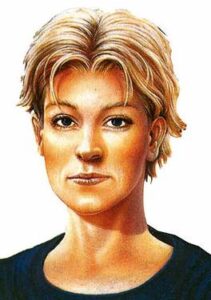


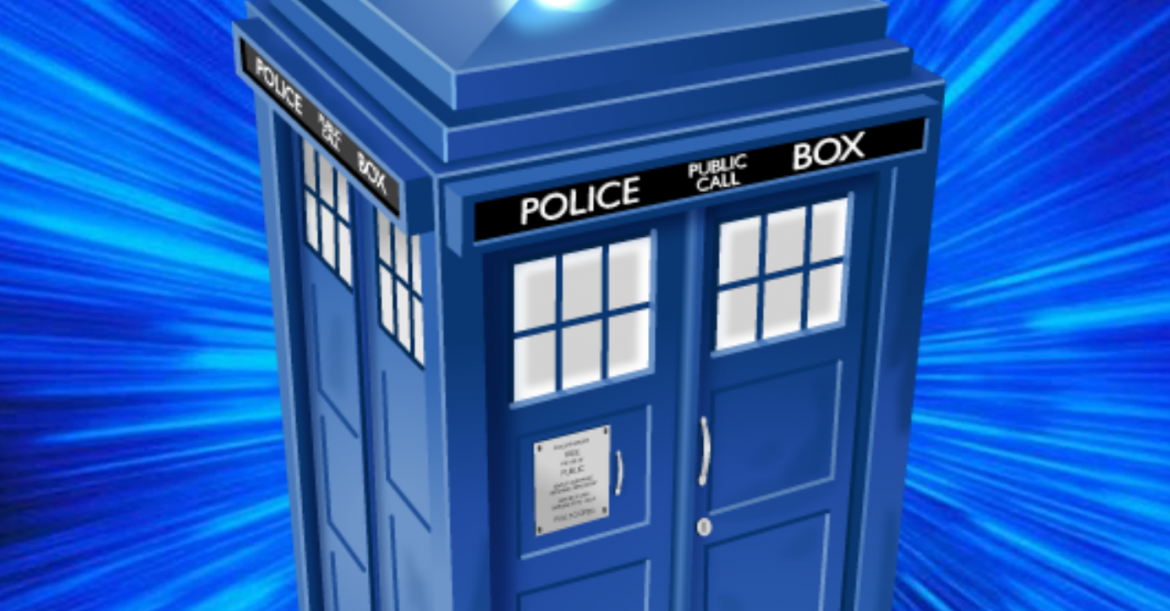
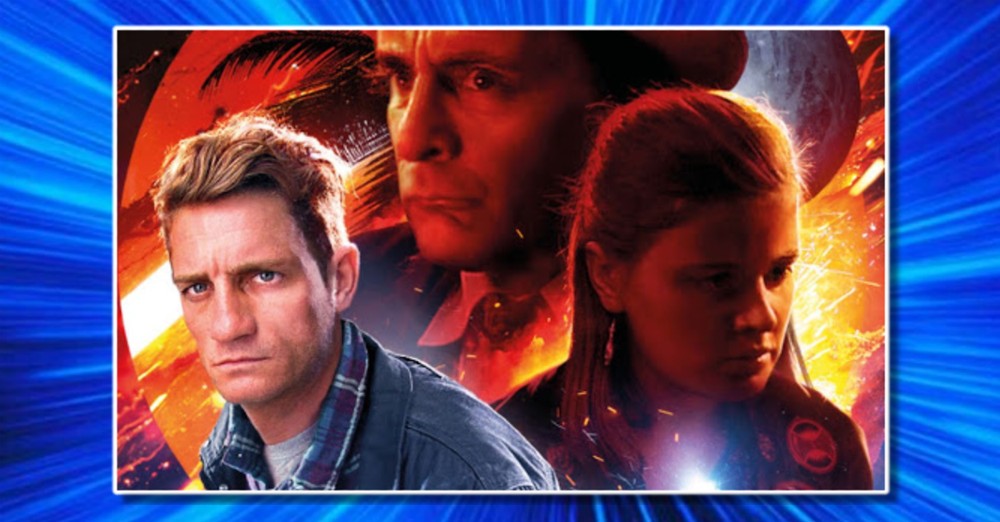
 We’re introduced to Hex in
We’re introduced to Hex in  he gets thrown in the deep end as the Doctor disappears and Hex and Ace end up splitting up.
he gets thrown in the deep end as the Doctor disappears and Hex and Ace end up splitting up. While the Doctor shows up in all four parts, Ace doesn’t appear until Part 2 and Hex doesn’t appear until Part 3. There’s also no theme music denoting episodes. Instead, there’s a short bit of increased static and tiny fragments of recordings. The cast does exceptionally well in this, with McCoy giving another quiet performance until the end and even then, the shouting works well. We also get a bit of backstory on Hex when asked why he became a paramedic.
While the Doctor shows up in all four parts, Ace doesn’t appear until Part 2 and Hex doesn’t appear until Part 3. There’s also no theme music denoting episodes. Instead, there’s a short bit of increased static and tiny fragments of recordings. The cast does exceptionally well in this, with McCoy giving another quiet performance until the end and even then, the shouting works well. We also get a bit of backstory on Hex when asked why he became a paramedic. helps you fight your shadow self and come out a better, happier person. What could go wrong?
helps you fight your shadow self and come out a better, happier person. What could go wrong? Next in line is
Next in line is  revolving around the theft of the Veiled Leopard diamond similar to the Pink Panther franchise. I think it’s available on the Big Finish Sound Cloud and I think I tried listening to it several years back. I remembering being very confused about what was going on.
revolving around the theft of the Veiled Leopard diamond similar to the Pink Panther franchise. I think it’s available on the Big Finish Sound Cloud and I think I tried listening to it several years back. I remembering being very confused about what was going on. The next story is
The next story is  early spoilers (we’ll get to them in time) what he goes through later is a bit brutal.
early spoilers (we’ll get to them in time) what he goes through later is a bit brutal. After our visit to World War I, we have
After our visit to World War I, we have  wedding.
wedding. The first of these is
The first of these is  alien slug. When Ace goes to look at the database, the TARDIS seemingly crashes in a recently abandoned house and locks them out. It turns out the house is a smart house controlled by the latest AI, Harri and they’re in the Fenns in 2020. There’s a little bit where Hex mentions his time as if it’s a few years out instead of the next year saying something about this area having been all developed or something like that. (Wow, we’re coming up to the point of Hex being a present-day companion instead of near-future, a bit weird when you think about it.)
alien slug. When Ace goes to look at the database, the TARDIS seemingly crashes in a recently abandoned house and locks them out. It turns out the house is a smart house controlled by the latest AI, Harri and they’re in the Fenns in 2020. There’s a little bit where Hex mentions his time as if it’s a few years out instead of the next year saying something about this area having been all developed or something like that. (Wow, we’re coming up to the point of Hex being a present-day companion instead of near-future, a bit weird when you think about it.) The first story is
The first story is 
 Meanwhile, a space battle between the Daleks and a refugee convoy occurs in a nearby star system. A ship containing a Valkyrie squad (a squad made entirely of female soldiers) flees the battle and arrives on Bliss. Both the Valkyries and the TARDIS crew come across a research station on the planet. Soon, the Daleks arrive as well.
Meanwhile, a space battle between the Daleks and a refugee convoy occurs in a nearby star system. A ship containing a Valkyrie squad (a squad made entirely of female soldiers) flees the battle and arrives on Bliss. Both the Valkyries and the TARDIS crew come across a research station on the planet. Soon, the Daleks arrive as well. stories placed against the backdrop of history.
stories placed against the backdrop of history. This is the final installment in the Forge/Project trilogy after Project: Twilight and Project: Lazarus. As such, it brings the Forge, which has been lingering in the back of the Hex arc after appearances in No Man’s Land and Forty-five: Casualties of War, front and center. It also brings the fate of Hex’s mother into the foreground in the worst possible way.
This is the final installment in the Forge/Project trilogy after Project: Twilight and Project: Lazarus. As such, it brings the Forge, which has been lingering in the back of the Hex arc after appearances in No Man’s Land and Forty-five: Casualties of War, front and center. It also brings the fate of Hex’s mother into the foreground in the worst possible way. focus first on Hex who has been taken to a planet in the distant past where Evelyn has ended up and then on Ace as she tries to fix things while falling in love. The final episode brings these threads together for a heart-wrenching finale.
focus first on Hex who has been taken to a planet in the distant past where Evelyn has ended up and then on Ace as she tries to fix things while falling in love. The final episode brings these threads together for a heart-wrenching finale. With that out of the way, we have
With that out of the way, we have  and TARDIS, they meet an elderly couple Albert and Peggy Marsden and get caught up going through the motions of “Protect and Survive”, a pamphlet that in the real world was never distributed. It turns out that Albert and Peggy are Elder Gods (like Fenric) that are trapped in a pocket dimension after the Doctor stopped them from changing history and destroying the Earth. The pocket dimension is a two-week time loop of the start of nuclear war so that “Albert” and “Peggy” can learn to be human.
and TARDIS, they meet an elderly couple Albert and Peggy Marsden and get caught up going through the motions of “Protect and Survive”, a pamphlet that in the real world was never distributed. It turns out that Albert and Peggy are Elder Gods (like Fenric) that are trapped in a pocket dimension after the Doctor stopped them from changing history and destroying the Earth. The pocket dimension is a two-week time loop of the start of nuclear war so that “Albert” and “Peggy” can learn to be human. of Seven’s life) were test runs of the newly minted Black TARDIS.
of Seven’s life) were test runs of the newly minted Black TARDIS.
 has arrived, deliver news of Hex’s death like a good Commanding Officer should at the death of a soldier.
has arrived, deliver news of Hex’s death like a good Commanding Officer should at the death of a soldier. contracting the Swarm, which has lain dormant in the TARDIS since the Fourth Doctor’s time. Under the influence of the virus, he sets the TARDIS in motion to coordinates that lead to Titan.
contracting the Swarm, which has lain dormant in the TARDIS since the Fourth Doctor’s time. Under the influence of the virus, he sets the TARDIS in motion to coordinates that lead to Titan. The penultimate Hex story,
The penultimate Hex story,  Gods arc.
Gods arc.

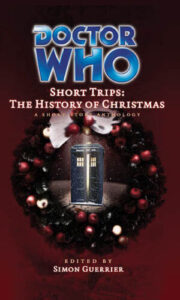

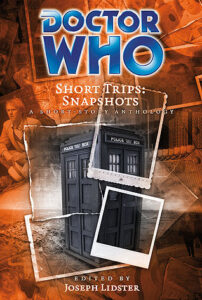
 While the New Adventures are said (I haven’t read that many of them, or very many that recently, so I can’t say from personal experience) to take the scheming, chess-master as far as it could go, the Big Finish stories seem to find a more balanced take on this incarnation. I’ve seen reviews (primarily from the blog Doc Oho) that state that the screaming Seven and Ace don’t work well, especially on audio. Part of me agrees, but then there are times, like the finale of LIVE 34, where it works so well.
While the New Adventures are said (I haven’t read that many of them, or very many that recently, so I can’t say from personal experience) to take the scheming, chess-master as far as it could go, the Big Finish stories seem to find a more balanced take on this incarnation. I’ve seen reviews (primarily from the blog Doc Oho) that state that the screaming Seven and Ace don’t work well, especially on audio. Part of me agrees, but then there are times, like the finale of LIVE 34, where it works so well. to Hex. When Hex dies, it affects Ace immensely giving us an excellent first episode of Afterlife.
to Hex. When Hex dies, it affects Ace immensely giving us an excellent first episode of Afterlife. I think the only place where his arc falls down is in the Hector trilogy and the Hex stories released post-Signs and Wonders. After such an amazing end in Gods and Monsters, did we really need more? Maybe. Probably not. Yes, I know I’ve referencing Doc Oho a lot here, but he often makes some good points. One is that Big Finish possibly kept the Hex arc going because they liked working with the actor Philip Olivier so much. I don’t know, it’s possible.
I think the only place where his arc falls down is in the Hector trilogy and the Hex stories released post-Signs and Wonders. After such an amazing end in Gods and Monsters, did we really need more? Maybe. Probably not. Yes, I know I’ve referencing Doc Oho a lot here, but he often makes some good points. One is that Big Finish possibly kept the Hex arc going because they liked working with the actor Philip Olivier so much. I don’t know, it’s possible.
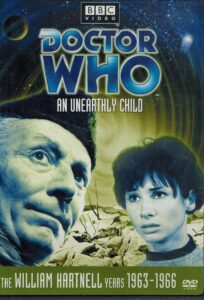 An Unearthly Child. The first Doctor Who story and famous in its own rite. This one is packaged as a four-part serial that introduces us to everything and then settles into a run-of-the-mill caveman story. However, as the blog (and later book series) TARDIS Eruditorum puts forth, this is actually two different stories: the one-part “An Unearthly Child” and the three-part “100,000 BC”.
An Unearthly Child. The first Doctor Who story and famous in its own rite. This one is packaged as a four-part serial that introduces us to everything and then settles into a run-of-the-mill caveman story. However, as the blog (and later book series) TARDIS Eruditorum puts forth, this is actually two different stories: the one-part “An Unearthly Child” and the three-part “100,000 BC”.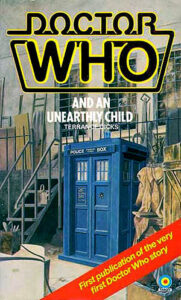 The novelization was published in October 1981 and written by Terrance Dicks. It’s good, not terribly meaty in greatly expanding the story, but it’s very readable. It follows the TV episodes quite faithfully and for a young reader (especially one who’s never seen the actual episodes) it paints a good picture of the landscapes and surroundings, expanding them past painted background and a few pieces of set dressing. As it stands, this was also my introduction to the Target novelizations. Something that really stood out to me in this was a couple of little historical clarifications for the readers of 1981 (and today) about Police Boxes (which were commonplace in 1963 but nearly extinct in 1981) and the UK adopting a decimal system for a currency which was a major point in making Susan seem alien. Dicks writes: “At this time, the early 1960s, Britain was still sticking to her uniquely complicated monetary system…” which he then breaks down briefly for the reader. (For the record, the UK adopted a decimal system for currency in February 1971.)
The novelization was published in October 1981 and written by Terrance Dicks. It’s good, not terribly meaty in greatly expanding the story, but it’s very readable. It follows the TV episodes quite faithfully and for a young reader (especially one who’s never seen the actual episodes) it paints a good picture of the landscapes and surroundings, expanding them past painted background and a few pieces of set dressing. As it stands, this was also my introduction to the Target novelizations. Something that really stood out to me in this was a couple of little historical clarifications for the readers of 1981 (and today) about Police Boxes (which were commonplace in 1963 but nearly extinct in 1981) and the UK adopting a decimal system for a currency which was a major point in making Susan seem alien. Dicks writes: “At this time, the early 1960s, Britain was still sticking to her uniquely complicated monetary system…” which he then breaks down briefly for the reader. (For the record, the UK adopted a decimal system for currency in February 1971.)
 First, let’s talk briefly about the author. David Whitaker is up there among the people who majorly shaped early Doctor Who. He was the show’s first Script Editor covering the period from An Unearthly Child through The Dalek Invasion of Earth and wrote eight TV stories including both Power of the Daleks and Evil of the Daleks.
First, let’s talk briefly about the author. David Whitaker is up there among the people who majorly shaped early Doctor Who. He was the show’s first Script Editor covering the period from An Unearthly Child through The Dalek Invasion of Earth and wrote eight TV stories including both Power of the Daleks and Evil of the Daleks. Ian isn’t present that are dropped or told secondhand. Whereas the TV version tends to drag in the middle, this clips along at a decent pace and the environment and descriptions aren’t limited to a TV budget. The chasm scene, which tends to drag in the TV story, is thrilling and the death of a secondary character carries more impact here. On the whole, it was enjoyable. Just, a bit unusual. I’d rate this a 7/10.
Ian isn’t present that are dropped or told secondhand. Whereas the TV version tends to drag in the middle, this clips along at a decent pace and the environment and descriptions aren’t limited to a TV budget. The chasm scene, which tends to drag in the TV story, is thrilling and the death of a secondary character carries more impact here. On the whole, it was enjoyable. Just, a bit unusual. I’d rate this a 7/10.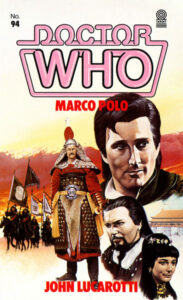 always had to have a monster even if the story didn’t really need one. I’d love to see all the missing episodes found or at least animated, as this is quite high on my list of missing stories to recover/animate. Not only would it allow for a Season 1 Blu-ray boxset, but it’s also just a good story. I rate it at an 8/10 or 9/10, but being able to see it might bring it higher, or lower though that’s unlikely. The novelization was published in April 1985 and was written by the TV Story’s author, John Lucarotti. Traveling the Vortex reviewed the half-hour recon of this that was included on “The Beginning” DVD set in Episode #41 back in October 2011.
always had to have a monster even if the story didn’t really need one. I’d love to see all the missing episodes found or at least animated, as this is quite high on my list of missing stories to recover/animate. Not only would it allow for a Season 1 Blu-ray boxset, but it’s also just a good story. I rate it at an 8/10 or 9/10, but being able to see it might bring it higher, or lower though that’s unlikely. The novelization was published in April 1985 and was written by the TV Story’s author, John Lucarotti. Traveling the Vortex reviewed the half-hour recon of this that was included on “The Beginning” DVD set in Episode #41 back in October 2011.
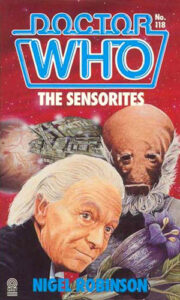 The Sensorites. This one is okay. It’s a sci-fi piece with weird-looking aliens and a small crew of space explorers. It’s also two episodes too long and kinda takes a left turn halfway through. The first episode is really atmospheric and creepy. The rest is, okay but not great. I rate this at 5/10. Traveling the Vortex reviewed this story in Episode #214 back in February 2015.
The Sensorites. This one is okay. It’s a sci-fi piece with weird-looking aliens and a small crew of space explorers. It’s also two episodes too long and kinda takes a left turn halfway through. The first episode is really atmospheric and creepy. The rest is, okay but not great. I rate this at 5/10. Traveling the Vortex reviewed this story in Episode #214 back in February 2015. to watch again (at least on DVD as I’ve noticed that as far as I can tell, Britbox, which I don’t have a subscription to, doesn’t have any missing episode stories even if they’ve been animated). I like the animated episodes. I’ll take them over recons any day even if the animation is a bit stilted. I don’t remember much about the specific details of the animation since it’s been years since I’ve watched this one.
to watch again (at least on DVD as I’ve noticed that as far as I can tell, Britbox, which I don’t have a subscription to, doesn’t have any missing episode stories even if they’ve been animated). I like the animated episodes. I’ll take them over recons any day even if the animation is a bit stilted. I don’t remember much about the specific details of the animation since it’s been years since I’ve watched this one. So that’s the stories, what about the main cast? We have to start with the Doctor. He’s definitely not the hero we know and love. He’s violent, arrogant, and suspicious of everyone, possibly to the point of being paranoid. Yes, Hartnell does have that twinkle in his eye and he has a soft side and a fun sense of humor but it takes those a while to surface. We get bits of it in the Aztecs, but it’s not really until season 2 and the arrival of Vicki that that sense of humor really surfaces. The building blocks are there for our Doctor, but they’re still being refined. Tardis Eruditorum (which is definitely worth checking out) puts forth that Hartnell’s Doctor is very much a background figure rather than a leading man and I tend to agree.
So that’s the stories, what about the main cast? We have to start with the Doctor. He’s definitely not the hero we know and love. He’s violent, arrogant, and suspicious of everyone, possibly to the point of being paranoid. Yes, Hartnell does have that twinkle in his eye and he has a soft side and a fun sense of humor but it takes those a while to surface. We get bits of it in the Aztecs, but it’s not really until season 2 and the arrival of Vicki that that sense of humor really surfaces. The building blocks are there for our Doctor, but they’re still being refined. Tardis Eruditorum (which is definitely worth checking out) puts forth that Hartnell’s Doctor is very much a background figure rather than a leading man and I tend to agree.
 I love Ian and Barbara, easily the best characters this season and very much a couple by the end. It’s hard to separate them when doing things like companion rankings. Ian’s the man of action that disappeared after Troughton and Barbara is a very capable woman. Yes, she gets the damsel-in-distress moments at times, but she’s written well and for the most part, is resourceful and enjoyable. At this point, this is more their show than the Doctor’s. Even when compared to the great companions of later eras, they still rank quite high. As with most of the Classic Who actors, I haven’t seen anything with William Russell or Jacqueline Hill outside of Who, though seeing Hill in a very different role many years later in Meglos gives me a slight indication of her acting ability and range.
I love Ian and Barbara, easily the best characters this season and very much a couple by the end. It’s hard to separate them when doing things like companion rankings. Ian’s the man of action that disappeared after Troughton and Barbara is a very capable woman. Yes, she gets the damsel-in-distress moments at times, but she’s written well and for the most part, is resourceful and enjoyable. At this point, this is more their show than the Doctor’s. Even when compared to the great companions of later eras, they still rank quite high. As with most of the Classic Who actors, I haven’t seen anything with William Russell or Jacqueline Hill outside of Who, though seeing Hill in a very different role many years later in Meglos gives me a slight indication of her acting ability and range.

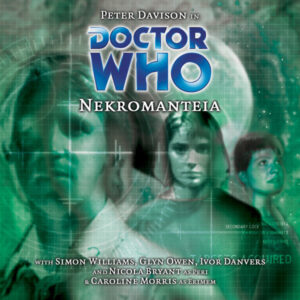 41
41 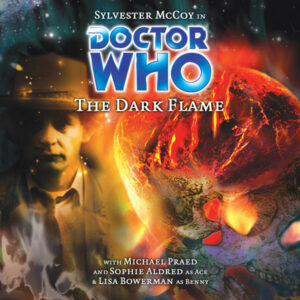 42
42  43
43 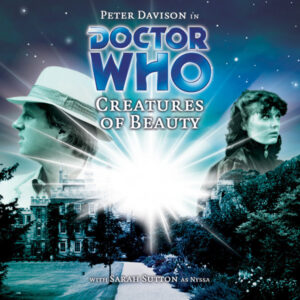 44
44 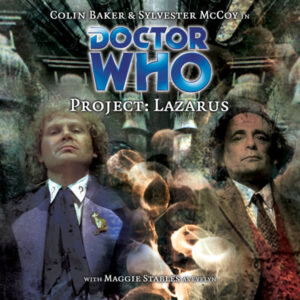 45
45 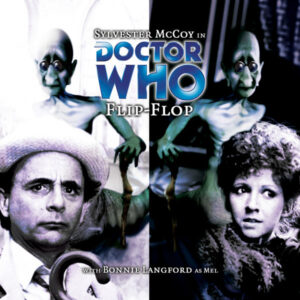 46
46 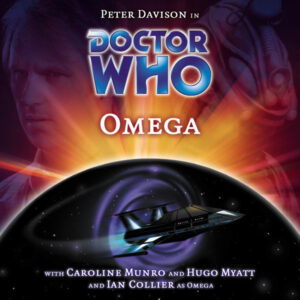 47
47  48
48 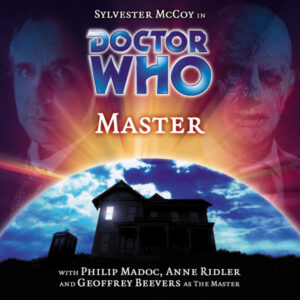 49
49 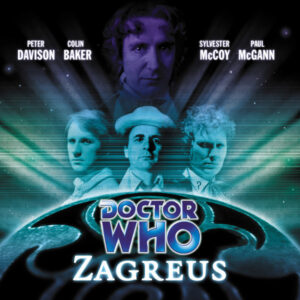 50
50  Volume 1
Volume 1 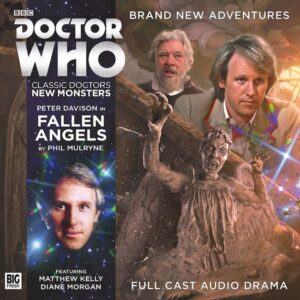
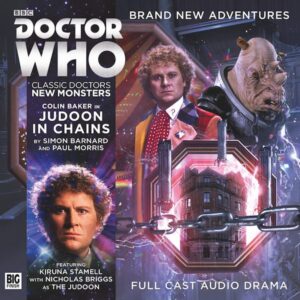 1.2 Judoon in Chains
1.2 Judoon in Chains 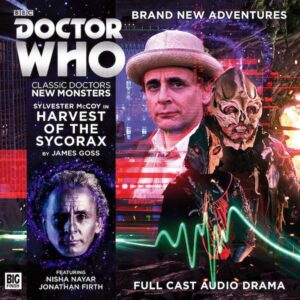 1.3 Harvest of the Sycorax
1.3 Harvest of the Sycorax  1.4 The Sontaran Ordeal
1.4 The Sontaran Ordeal  Volume 2
Volume 2 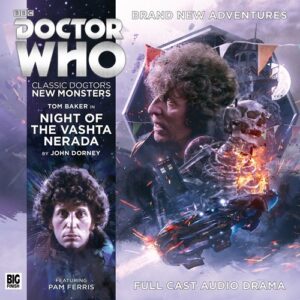 2.1 Night of the Vashta Nerada
2.1 Night of the Vashta Nerada 2.2 Empire of the Racnoss
2.2 Empire of the Racnoss 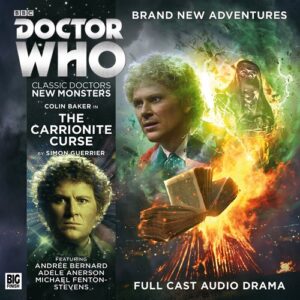 2.3 The Carrionite Curse
2.3 The Carrionite Curse  2.4 Day of the Vashta Nerada
2.4 Day of the Vashta Nerada  1.1 Destination: Nerva
1.1 Destination: Nerva 1.2 The Renaissance Man
1.2 The Renaissance Man  1.3 The Wrath of the Iceni
1.3 The Wrath of the Iceni  1.4 Energy of the Daleks
1.4 Energy of the Daleks  1.5 Trail of the White Worm
1.5 Trail of the White Worm  1.6 The Oseidon Adventure
1.6 The Oseidon Adventure  Last of the Titans
Last of the Titans  The Ratings War
The Ratings War
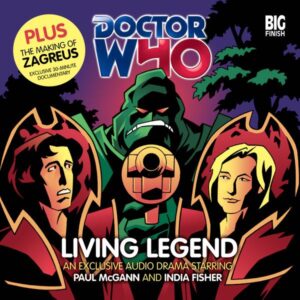 Living Legend
Living Legend Cuddlesome
Cuddlesome